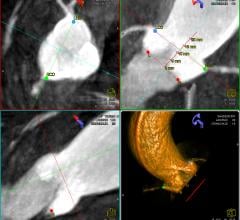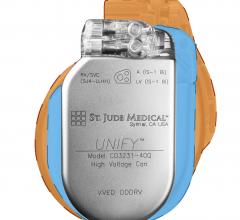The Society of Cardiovascular Computed Tomography (SCCT) announced the publication of the SCCT Expert Consensus Document on Computed Tomography Imaging Before Transcatheter Aortic Valve Implantation (TAVI)/Transcatheter Aortic Valve Replacement (TAVR) in the Journal of Cardiovascular Computed Tomography (JCCT).

A report from the CathPCI Registry, a data registry that includes information from 85 percent of the heart catheterization laboratories in the United States, is providing a vivid snapshot of the current practice of invasive cardiology.

Abbott announced that the Xience Xpedition everolimus-eluting coronary stent system received U.S. Food and Drug Administration (FDA) approval and is launching immediately in the United States, providing physicians with a next-generation technology with the largest size matrix in the U.S. market.
Providing exceptional cardiovascular care for patients to achieve the best possible outcomes is the number one goal for ...
The Medical Imaging and Technology Alliance (MITA) said that failure to delay the new medical device excise tax, along with Medicare cuts for imaging and radiation therapy services passed by Congress as part of the “fiscal cliff” package, will hinder patients’ access to early disease detection and therapy services and threaten American medical technology jobs.
Siemens Healthcare recently received clearance from the U.S. Food and Drug Administration (FDA) for syngo Aortic ValveGuide, an integrated image processing software that helps cardiologists and cardiac surgeons prepare and perform transcatheter aortic valve replacement (TAVR). The syngo Aortic ValveGuide automatically reconstructs a 3-D representation of the aortic root from cross-sectional images acquired with the angiography system and provides the best projection angle for the valve replacement. The software selects anatomical landmarks and overlays the 3-D image with 2-D images acquired during live fluoroscopy, enabling the physician to obtain real-time 3-D guidance in the patient’s body while navigating the new valve to its intended location. This groundbreaking software, which is now available to customers, reflects the spirit of Siemens Healthcare’s Agenda 2013 — a recently announced two-year initiative designed in part to strengthen the Healthcare Sector's innovative power and competitiveness.
Philips Royal Electronics and Unfors RaySafe AB announced the signing of a Joint Development Agreement that will see the development of the next generation Philips DoseAware system, with the aim of offering seamless access and communication between Philips DoseAware and Philips Allura interventional X-ray systems.
Cardiac positron emission tomography (PET) is growing in popularity among cardiologists because it provides the ability ...
At RSNA 2012 Montage Healthcare Solutions and Radimetrics demonstrated the benefits of correlating dose information with Montage clinical report search results.
St. Jude Medical Inc. (announced European CE mark approval of the Assura portfolio of implantable cardioverter defibrillators (ICDs) and cardiac resynchronization therapy defibrillators (CRT-Ds). The Assura family of devices, featuring Shockguard technology has three new algorithms that help protect patients against inappropriate shocks while providing the highest amount of delivered energy. These improvements are projected to reduce inappropriate therapy by 74 percent, allowing for more effective therapy. Products currently available in Europe include the Quadra Assura CRT-D, Unify Assura CRT-D and Fortify Assura ICD.

The introduction of new technology into the magnetic resonance imaging (MRI) landscape has changed the face of the market segment over the last year. Although MRI satisfaction scores tend to cluster together, the differences are in the details, according to recent findings from healthcare technology research firm KLAS in its report MRI 2012: Broadening Your Field of View.
When performing radiofrequency (RF) ablation to treat cardiac arrhythmia, medical professionals must balance the safety ...

When tests reveal that a patient’s heart artery is blocked and blood flow to the heart is restricted, should the doctor fix it with a stent or stop the test and discuss treatment options with the patient? Recommendations published by the Society for Cardiovascular Angiography and Interventions (SCAI) provide new guidance on when physicians should move forward immediately to open a blocked artery versus when to stop the test for further discussion with the patient or consultation with a heart surgeon.
RamSoft announced its partnership with Digisonics to offer integrated, vendor-neutral cardiac post-processing and structured reporting for all cardiovascular modalities. Digisonics was recently named Best in KLAS for the Cardiology market segment for the fifth consecutive year.
According to Millennium Research Group (MRG), approximately 80 percent of transcatheter aortic valve replacement (TAVR) procedures are being performed on high-risk patients who are ineligible for surgical heart valve replacement. New clinical evidence that supports TAVR in treatment of intermediate and high-risk operable patients has led to expanded reimbursement for a new patient base for the procedure.
Change Healthcare Cardiology Hemodynamics is an integrated hemodynamic monitoring system for monitoring vital signs and ...
Merge Healthcare Inc. announced that Merge Hemo has been named the "Category Leader" in the "2012 Best in KLAS Awards: Software & Services" report for Cardiology Hemodynamics rankings for the second consecutive year.

Some stroke patients may benefit from cerebral angioplasty and stent placement, according to a new study published online in the journal Radiology.
The first patient has been implanted with the Boston Scientific Corporation next generation Ingevity pacing leads in a clinical trial designed to establish the safety, performance and effectiveness of the leads. Pacing leads are insulated wires that connect an implantable pacemaker to the heart for treatment of bradycardia, a condition in which the heart beats too slowly, depriving the body of sufficient oxygen. Pacemakers work in conjunction with leads to sense and stimulate (or pace) the heart, thus maintaining an appropriate heart rate for a given level of physical activity.

 January 03, 2013
January 03, 2013








